How do you know you have gout if you don't go to the hospital?
Gout is a disease that is indeed becoming more and more prevalent nowadays, according to data from the 2019 China Hyperuricemia and Gout Treatment GuidelinesWe have 1% of the gout population in this country., which can be described as aLarge patient base. I believe that many of you reading this article must have come into contact with gout sufferers around him, or some of them have been found to have it in the course of medical checkupshyperuricemia, some friends are also more worried about their high uric acid will suffer from gout, so they are more concerned about whether they can through some symptoms or the first signs of.Not going to the hospital to determine if you have goutSo can you do it?
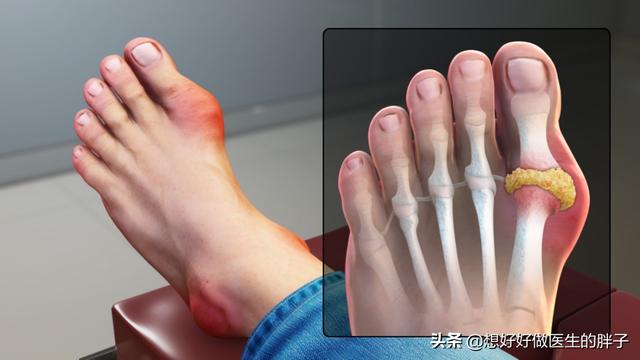
Let's start by understanding gout and high uric acid!
goutThis disease is the result of our body'sPurine metabolismAbnormalities have occurred, resulting in abnormally elevated uric acid, and long-term elevated uric acid is the result of uric acid being in aoversaturationThe state of affairs that culminates in the formation ofUrate crystals.These urate crystals are deposited in our body and slowly getting more and more, they may trigger an attack of gout.
And this one.What is a normal uric acid value? It's 420.If the continuousTwice, on an empty stomach, and not on the same day.Measurements of blood uric acid all exceed this value, then the diagnosis ofHyperuricemia, which is the pathological basis of gout attacks。
I believe we have many friends around us who know they have high uric acid, and there are some friends who may have very high uric acid, which can be as high as 600 700, but these friends do not develop gout, soThinking that as long as the uric acid is abnormal without issued gout is fineThis idea is wrong. This is because a prolonged period of hyperuricemia increases one's risk of hypertension, diabetes, and cardiovascular disease, and a prolonged period of hyperuricemia can cause one to have aUric acid stonesEventuallyIt affects the functioning of the kidneys, which may cause renal insufficiency or even kidney failure.
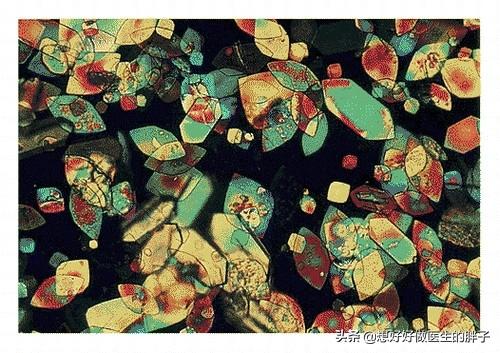
而Gouty attacks are part of a crystalline inflammatory response, when gout flares up, these urate crystals go haywire and our body'sleucocyteTrying to get rid of it, but because the urate crystals are particularly sharp, right in theThe white blood cells are destroying it in the process of destroying the white blood cells.It causes a lot of inflammatory factors to be released into the area of the attack, so the patient will showParticularly severe, flare-up site painand the localization will be rapid.肿胀Up. Surface.The skin temperature will rise., and some patients may even developAbnormalities in body temperature。
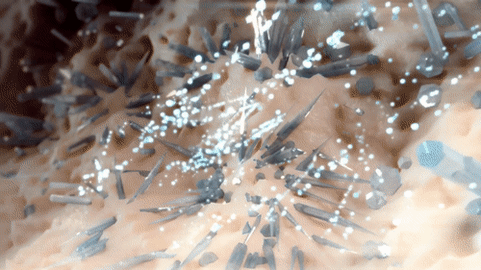
Why do I have to give you such a detailed introduction? It's because nowThere's a lot of rumors., tell you can go through some symptoms to determine whether you have high uric acid whether you have gout, what are they?
Some myths about determining whether uric acid is elevated on your own!
●Frothy urine is high uric acidThe reason for this is the fact that it is so common to see more bubbles in the urine! This statement is too common, many friends pay attention to their urine, see more foam in the urine, they begin to doubt whether they are abnormal uric acid, in fact, this can not be sure, there are too many reasons for more foam in the urine, theThere are some causes of diseaseFor example, there areproteinuriabut (not)There are some dietary factors thatThis leads to more impurities in the urine and more foam!

Some time ago Dr. Hsiehmake coffeeof the time, it suddenly occurred to me that I could explain this to you with this example, where you can make your own cup of coffee andThe water flows a little faster when you pick it upThe reason why you will find a lot of foam in your cup and it will last for a while without dissipating is the same as if there are a lot of impurities mixed in our urine, it will lead to foam, and the reason why you will find a lot of foam in your cup is the same as if there are a lot of impurities mixed in our urine.There is absolutely no need to be overly anxious about the possibility of gout because of high foam, thinking that too much uric acid could be。
●Blood in the urine means high uric acid. There are actually a lot of statements like this, and there are times when if when a person with gout or a person with hyperuricemia has developed aUric acid stonesThen these small stones will slowly may fall into the ureter, stimulate to the ureter will induce the patient to appear hematuria, but this is also the result of the patient has formed kidney stones, and not because of hematuria to judge the patient, uric acid has been elevated.

●Sleeping with back pain means high uric acidThis is a joke! This is more of a big joke, there are so many reasons for back pain while sleeping, such as fasciitis of the lower back, strain of the muscles of the lower back, such as lumbar disc herniation such as lumbar spondylolisthesis, and if you judge that uric acid is elevated purely by having back pain while sleeping is a little bit of a pipe dream, too much of a joke.
There are many other legends, please don't believe themBecause many times there are no special symptoms when our body has high uric acid, our body will not feel anything, this situation isAsymptomatic hyperuricemiaand want toDetermining whether or not uric acid is elevated is very simple, we just go to the hospital and have blood tests doneThis lab test is not expensive and the results are quicker, a quick test can be done in two to three hours, a routine test takes 4 to 5 hours and the results are out, and there are stillUric acid test for home use, you can measure your uric acid value relatively quickly.
So, can you tell if you are having a gout attack by some of the symptoms?
As has already been said.Gout induces very typical redness, swelling, heat, and pain in patients, at the time of the first attack, it tends to be more common to be located in the area of our toes, but it is not absolute, gout that occurs in the elbows, knees, fingers, as well as wrists is becoming more and more common.
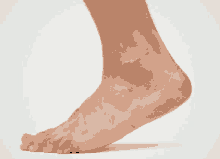
If you develop significant redness, swelling, heat and pain in a joint or area.Seizures occur in the second half of the night., or at a time whenOvereating, catching cold, staying up all nightorcontraindicationAfter that, then it is important to consider the possibility of gout, but want toIt is not scientific to determine that you have gout by these symptomsThe blood uric acid test must be performed in the hospital, and the diagnosis should be confirmed with the help of a professional rheumatologist wanting to, it is still too simple to judge purely by the symptoms.
There are also some high-risk factors for gout, which you must be aware of. When you have these high-risk factors, and joint pain occurs, consider the possibility of gout, which Dr. Xie briefly listed for you:
:: There areFamily history of gouty attacks。
WeightBeing overweight or obeseI usually prefer to eatHigh in salt, calories, fat, and purinesFood.

intensedrinking wine, especially excessive alcohol consumption, either liquor or beer.
Favoritephysical exerciseof the population.
● There are someInternal MedicinePatients who need to take oral aspirin for a long time, or some antihypertensive drugs containing diuretic ingredients, patients with chronic kidney disease, and other patients taking medications for a long time should pay attention to their uric acid.
:: Long-term drinkingPeople who drink carbonated beverages and beverages with high fructose contentThe most important thing is that they are young people.
● People with diabetes, high blood pressure, or coronary heart disease should keep an eye on their blood uric acid.
summarize
It's essential to care about your blood uric acid, the13.3% of our nation's population is now in a state of abnormal uric acid.Many patients with abnormal uric acid are at risk of developing gout, theHowever, we should not overdo it, nor should we worry about the sky and sleep., don't start worrying every day about whether you are having a gout attack just because you are experiencing pain in one of your joints!
Go to the hospital for a simple blood uric acid test to clarify whether your blood uric acid is too high, and ask a professional rheumatologist to help you check and identify it.
而Trying to want to simply go by your symptoms at home isn't impossible, but it's not scientific enough, it must be better with the help of a doctor, and many of my friends are now surrounded by gout sufferers.Taking medication indiscriminately if you suspect you have goutThis is very wrong behavior, and every year we hear about patients who areUnauthorized use of some of the so-called uric acid-lowering drugs, the treatment of gout special drugs and lead to kidney failure patients, which is too worthless。
Please, we must believe in science.Whether you want to go to the hospital or not, the hospital is there., if you suspect that you may have gout, then go to the hospital for a professional checkup.Perform dual-energy ct, blood uric acid test, or ultrasoundThis will help you to determine whether or not there are deposits of urate crystals in certain parts of the body, and will help you to determine whether or not there is a possibility of a gouty attack.Never blindly self-judgment and self-treatment at home, leading to delays in the disease。
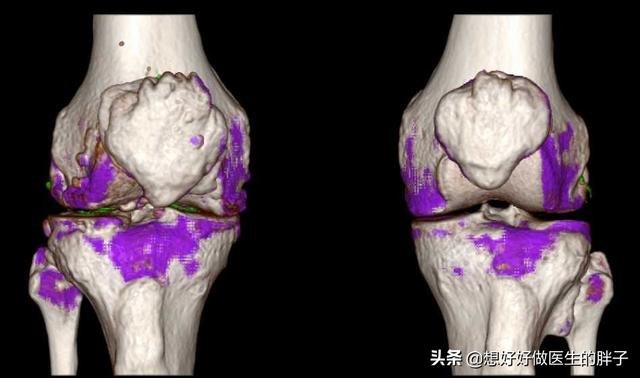
I adhere to the simple language to explain the complexity of disease knowledge Xie Xinhui, code word is not easy, if you agree with my point of view, please help to point a concern or click a like it, if you or your family and friends also have gout in this area of trouble, please forward this article to the need of their it, thank you! (The above content is only as a medical science, does not have any diagnostic and treatment value, if, you suspect gout, must go to the hospital for professional examination, part of the picture from the network infringement deleted)

Gout is a group of diseases that cause tissue damage due to increased blood uric acid as a result of purine metabolism disorders. The lesions often invade the joints, kidneys and other tissues, so how to determine whether gout?
How to determine whether the gout mainly depends on the joints. At the beginning of the onset of 53% to 70% of patients have first toe joints (called foot gout) red, swollen, hot and painful, usually multiple, some can also be manifested as multiple joints. It is fixed and asymmetric, and can gradually invade larger joints such as ankles, knees, wrists and elbows.
Gout tends to develop more rapidly, and more in the night attack, the pain is very intense, a few hours to reach the extreme, and even can not stand to be covered by a blanket, usually lasts a few days to 2 ~ 3 weeks of self-relief, subsiding skin can be seen after the fall of flakes and itching, for the characteristics of this disease.
There are gouty nodules around the joints or in the earwigs, and in the case of longstanding gout, the joints are atrophied, deformed, and often ulcerated, with a chalky discharge from the wound.
Gout symptoms are a sign of gout and it is best to go to a proper place to get checked and diagnosed.
Not many people want to go to the hospital because they want to solve their problems in the most "cost-effective" way, but I would say the only thing that can't be done is to go to the doctor!
Of course, that's not to say that all of us don't realize that we have gout until we go to the hospital and get tested!
when all is said and doneGout is a crystal-associated arthropathy caused by monosodium urate (MSU) deposits in the joints.Many gout patients are still quite characteristic, and we usually can indeed suspect whether we have gout by following these typical symptoms!
The first, first symptom is often joint pain and is predominantly in the feet, especially the big toe!
Why our big toe? The reasoning is simple. You can try to get your own body links.You'll notice that this joint area is a relatively cooler part of the body.If you have studied physics or know about solubility, you will know that the higher the temperature, the greater the solubility, and on the contrary, the lower the temperature, the smaller the solubility! Just like we usually dissolve sugar and salt water, is it easier to dissolve sugar and salt in water with higher temperature? And lower temperature is not more difficult to dissolve, more likely to be deposited?This big toe joint is a little bit of this, and the low temperature is then more conducive to the formation of our urate crystals, leading to tissue damage and causing inflammatory pain!
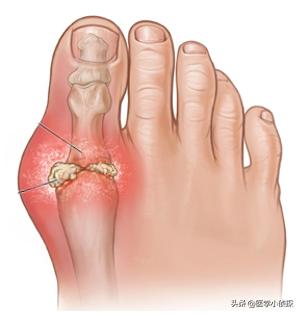
Also, thisThe big toe joint is also the most vulnerable joint to trauma., and minor trauma can cause a change in the local pH around our joints, again favoring the deposition of uric acid crystals.Of course, we say that gout-induced joint pain is not limited to this place, like our dorsum of the foot, ankle, knee joints, etc. are common parts, and there is usually no symmetry, and the pain localized by touching the foot has redness, swelling, and heat, in addition to the skin is hot to the touch.
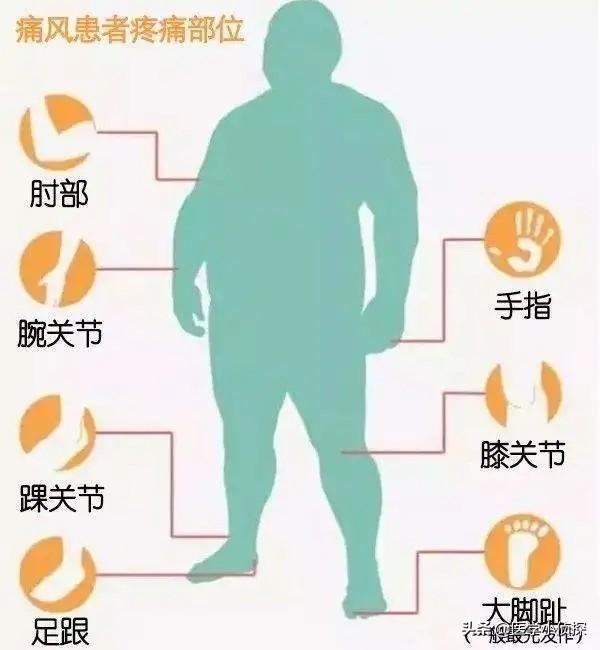
Second, joint pain is more likely to occur at night!Like our emergency department, some of them are patients with acute attacks of gout at night, patients often come with unbearable pain, unable to walk on their own, and most of them can be found to have high uric acid through blood tests when asked by our doctors.
Why does gout tend to strike at night?For one thing, when we people sleep at night.Blood circulation is slow; Secondly, in gout patients, including our normal people, the blood is acidic at night, but in our normal people after eight o'clock in the evening, it has an alkaline tide, when the normal people's blood is alkaline.This is not the case with this patient with high uric acid, who has always been on the acidic side and has acidic uric acid, so being on the acidic side makes him more susceptible to uric acid deposits. So, most of this gout patients develop at night!
Therefore, we say that if you have pain in the joints of your feet at night, especially in the big toe joints, there is a high probability that you have gout, especially if you have eaten a lot of fish, beer, seafood and so on in the past few days, the probability is even higher!
However, I don't recommend that you diagnose yourself with gout just by the way this symptom manifests itself and not going to the hospital for a checkup, why?
There are two main aspects:
The first aspect: the diagnosis of gout by symptomatic manifestations has a certain misdiagnosis rate, gout must also be distinguished from the following diseases!
The first, gout must be associated with ourerysipelasIdentification. Dengue is usually our B streptococcal infection of the skin disease, it hurts also red, swollen and hot, and even hot. Patients like this are often treated with some penicillin and they are fine, especially in the past there were really many people who treated gout as dengue, why?
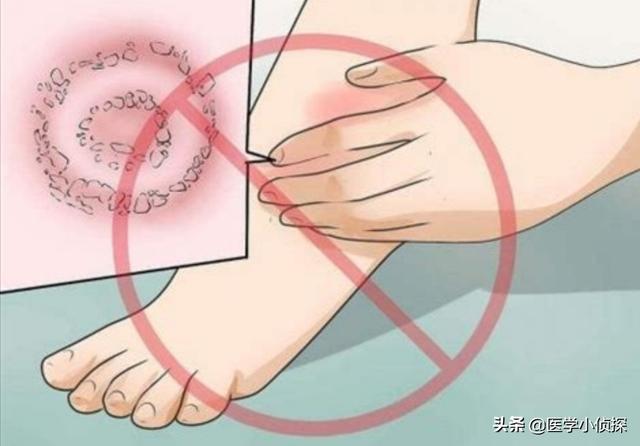
It's very simple. The symptoms are similar.Especially before you may be dengue, with penicillin after the good, the results of this time and pain, also thought it was dengue, hit the penicillin after a few days also seems to be relieved, and so on and so forth, thought they must have dengue, and then a certain relief can not be relieved, the pain can not stand, to the hospital, a check is gout!Because gout is a self-limiting disease when it's not serious in the early stages, that is, even if you don't care about it, don't treat it, it can get better after a few days, or a week or two, so at that time, when you treat it with penicillin for a few days, it's actually curing itself, so this gout has to be differentiated from our danmu.
The second is that this gout has to be distinguished from our rheumatoid arthritis and rheumatoid arthritis.One is called recurrent rheumatism, and this is more, and probably less heard of if not by rheumatologists, what the extent of this disease is.
Rheumatism and rheumatoid can be said to be the two diseases that are most easily confused by many people in our clinic.
First.The etiology of the two would be different!Rheumatism is a disease closely related to hemolytic streptococcal infections in humans, whereas rheumatoid is an immune system disease generally associated with mutations in immune genes.
Secondly.Rheumatism most often starts with acute fever and joint pain, stereotypical symptoms in addition to fever, and generalized wandering pain as the main symptom.their jointsThere are usually no particularly obvious morphological changes, and the affected joints are mostly large joints such as knees, ankles, shoulders, elbows and wrists., also localized redness, swelling and heat, the pain tends to move from one joint to another, usually takes more than half a month to relieve, can be recurrent.

Rheumatoid, on the other hand, usually involves small joints, with chronic, symmetrical joint pain as the main clinical manifestationIt's just a pain in the symmetrical small joints of the right and left hands, and it's just good for the small joints of the hands, wrists, feet, etc., and it's recurring.symmetrically distributed. It also started out with red, hot, swollen joints and dysfunction, but it's getting worse and worseCan lead to joint deformities, atrophy of skeletal muscles, disability。
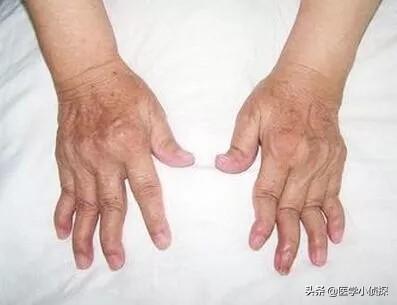
Then there is the difference between advanced gout, where the gout stone grows inside the skin in this area, and rheumatoid nodules, which are a small hard nodule that grows on the bone.

Finally, when we say gout, rheumatism, as well as rheumatoid rheumatism, for many of the common people it is necessary to take special care to distinguish between them, because, as you can see.The etiology is completely different; gout is high uric acid; rheumatism is a streptococcal hemolytic infection, while rheumatoid is an autoimmune diseaseThe cause of the disease is different, the treatment is definitely different, and this can be well identified by going to the hospital to avoid misdiagnosis!
The second aspect: the effect of gout on the body is far less simple than people think, it is just a pain, and it is not difficult to go to the hospital to diagnose gout, there is no need to take the risk of judging for yourself whether it is gout or not because of this!
Gout stones can be found on the bodies of almost all gout sufferers, and as the disease finds its way through the course of the disease, these gout stones continue to accumulate, thewreaks havoc on the joints of our limbs, leading to chronic joint swelling and pain, stiffness and deformity, and even fractures.
At the same time, 2/3 of our body's daily uric acid is metabolized, so for gout patients a chronic state of high uric acid can lead toGouty nephropathy, which can be severe enough to lead to renal insufficiency or even acute renal failure!
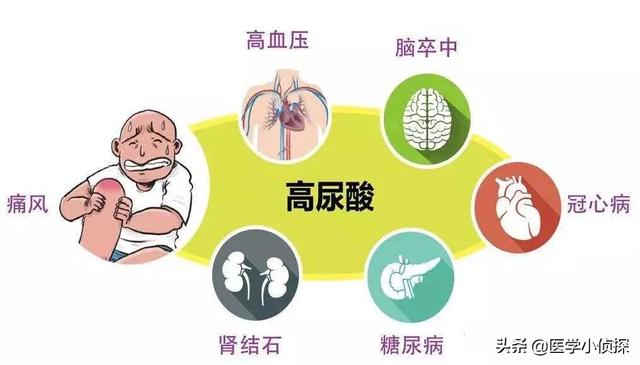
And then there's our clinical finding that10% to 25% of gout patients have renal uric acid stonesAnd kidney stones can have a serious impact on the life and work of many people. Therefore, gout is definitely not a disease that can be easily misdiagnosed!
The most important thing is that the diagnosis of gout in hospitals is now very simple and sophisticated!
In the first step, blood is drawn for uric acid, and hyperuricemia is diagnosed in adults with 2 fasting blood uric acid >420 μmol/L on non-same days;
The second step is to perform imaging tests, such as finding a "double-track sign" on the ultrasound or performing a "double-track" test.Dual-energy CT revealed urate depositsetc., and then orX-rays reveal soft tissue swelling, destruction of cartilage margins, and irregularities in the articular surface!
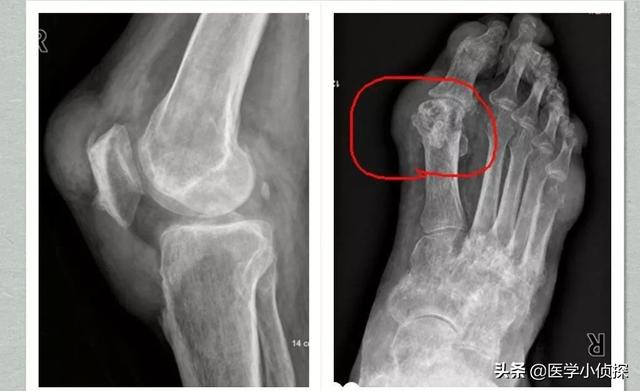
The third step, together with the presentation of clinical symptoms such as those joint pains mentioned at the beginning, basically leads to a definitive diagnosis.
Therefore, for gout, you still need to do tests for diagnosis under the guidance of a medical professional, in addition to avoiding misdiagnosis.The most important thing is still to be carried out under the guidance of a doctor to choose reasonable drugs for standardized treatment to avoid more serious complications!
with respect togoutIf you still have any questions, you can leave a message below, I adhere to the text we can understand, the most primitive way to bring you the best, the most comprehensive, the most practical health science and technology. If you think it's good, you can pay attention to the "medical detective" and forward yo, so that more people around the benefit!
Typical symptoms of gout are red, swollen and hot pain in the joints. The most commonly affected joint is the big toe (medical term: first metatarsal), while others are common in the ankle, knee and elbow joints. Symptoms often come on suddenly at night. The hospital examination is mainly to check the blood uric acid. However, it should be noted that some patients do not have high uric acid when they have gout attacks. It is still recommended to go to the hospital for examination and standardized treatment. Outpatient clinic often see self-abuse of painkillers lead to renal insufficiency, very unfortunate. Furthermore, not all patients with high uric acid will develop gout, but they will also have other risks, so high uric acid to a certain extent will need to be controlled by medication (see the headline article I posted).
How do you know you have gout if you don't go to the hospital for examination? In response to the owner's question, Dr. Wong understands that in the early stage of gout, what will be the manifestation symptoms?
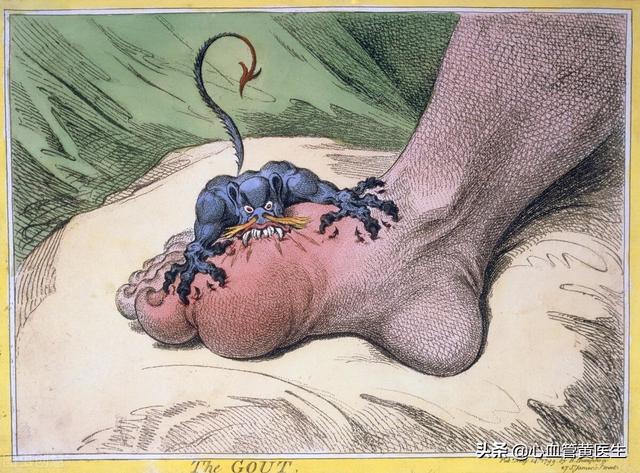
In the process of combating cardiovascular diseases, gout is also always with us, for the manifestation of gout symptoms, Dr. Huang naturally understand, the following to share with you, so that you learn to cognize gout at home also.
goutIt is a disease caused by high blood uric acid levels leading to the deposition of uric acid crystals in the joints. The deposited crystals lead to painful inflammatory episodes in and around the joints. The most typical manifestations aregout stone。
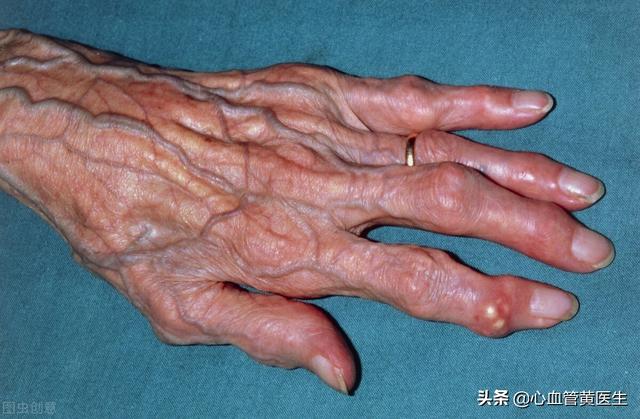
Patients with gout often experience sudden onset of severe pain in one or more joints, most often starting suddenly at night, and may experience redness and swelling of the joints, increased skin temperature, and red, tense, shiny skin on the joint surfaces.
The first few attacks usually involve only one joint and last for a few days, often resolving on their own within 2 weeks and then disappearing completely. However, if the disease continues to worsen and is not treated aggressively after an attack, the attacks will become more frequent and may even affect more than one joint, lasting up to 3 weeks or more.
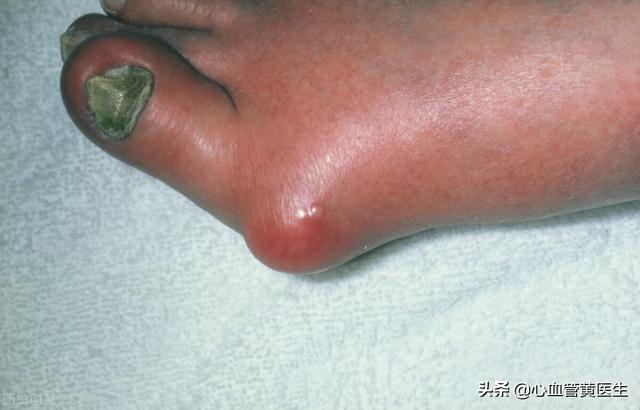
Repeated attacks can lead to aggravation and chronic progression of gout, resulting in deformity of the diseased joints. Finally, joint movement is progressively limited due to damage caused by the continuous deposition of urate crystals around the joints and tendons.
A condition that can be felt directly at home without going to the hospital, most often occurring early in the morning and at midnight, with severe pain in the joints, redness, swelling, heat, pain and dysfunction in the diseased joints.
This period of time belongs to the second course of the disease - acute arthritis period and the intermittent period, because in the time of elevated uric acid will not have external symptoms, this course of time, often each time will only be involved in a single joint, mostly accompanied by hyperuricemia, accompanied by fever (body temperature of more than 38.5 ℃), heartbeat, general malaise, skin pressure pain, chills and so on, such a week and not If the condition does not improve or subside in a week, it is recommended to consult a doctor.

I am Dr. Huang, a cardiovascular physician dedicated to helping you manage your body by explaining complex and difficult disease knowledge in plain words. Your kudos are my greatest motivation! Also, if you have a family member with gout-related troubles, please pass this article on to them!
How do you know you have gout if you don't go to the hospital?
I. Redness, swelling and pain in the joints
The toes, the area where urates tend to build up, and when gout strikes, the pain, literally, is excruciating.
In an acute attack of gout, the affected joints (most commonly the big toe and the dorsum of the foot) are often localized with significant redness, swelling, heat, pain and dysfunction.
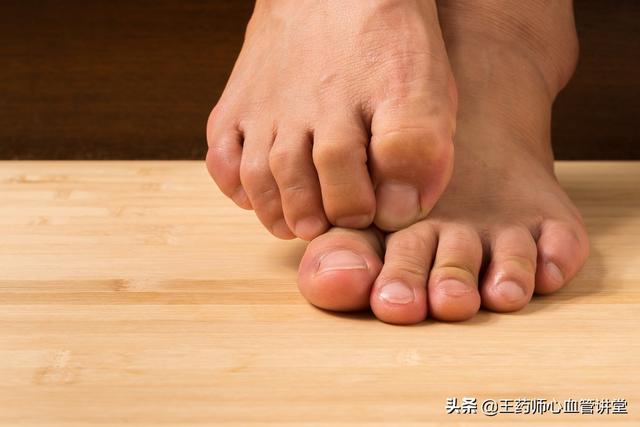
II. Discovering Gout Stones
The typical site of subcutaneous gouty stones is the auricle, and they are commonly found around recurrent joints, hawksbill, Achilles tendon, and patellar bursa. The appearance of subcutaneous elevated yellowish-white redundant organisms of varying sizes, the skin surface is thin, and white powdery or pasty material is discharged after rupture, which does not heal over a long period of time. Subcutaneous gouty stones often coexist with chronic gouty stone arthritis. Large deposits of gout stones in the joints can cause joint bone destruction, fibrosis of the periarticular tissues, and secondary degenerative changes.
III. Injury to the kidneys
Gout not only kills when it hurts, leading to gout stones and joint damage, but more seriously, kidney damage. Data show that 1/3 of people with long-term gout have kidney damage, which manifests as chronic gouty nephropathy, uric acid kidney stones and acute obstructive nephropathy. Some patients may have mild back pain, edema, hypertension, mild proteinuria, aciduria and hematuria.
What conditions can cause gout to occur suddenly?
Overeating, especially eating animal offal, shelled seafood, hot pot and other high-purine food, while drinking a lot of alcohol; joints catch cold, uric acid is more likely to form crystals at low temperatures;Catching cold after drinking alcohol is the most common trigger in life.
Gout can be detected by imaging, the presence of articular cartilage "double track sign" joint effusion, bone erosion, etc., can also be diagnosed by kidney function indicators.

Clinical indicators of renal function
When clinically speaking, renal function indicators include blood creatinine, urea nitrogen, and blood uric acid, commonly known as"Three kidney tests."It is evident that blood uric acid is closely related to renal function.
Excessive uric acid is deposited not only in the joints, but also in the renal interstitium, renal tubules and ureters, causing interstitial nephritis, renal tubular damage and uric acid kidney stones, which in time leads to kidney failure. Hyperuricemia definitely aggravates renal failure.
The most affordable way to lower uric acid
Drinking plenty of water dilutes the uric acid thatDrinking water is recommended to maintain a daily urine output of 2,000 to 3,000 ml. It is recommended that people with high risk factors for gout should control their diets in general, avoid the intake of high-purine foods, check their blood uric acid levels regularly, and be alert to gout and other metabolic diseases once hyperuricemia occurs.
Gout is also often accompanied by hyperlipidemia, hypertension, diabetes mellitus, atherosclerosis and coronary heart disease, etc., seriously endangering the life and health of patients and must be taken seriously!
I am Pharmacist Wang, dedicated to helping you manage your body by explaining complex and difficult disease knowledge in plain words. Your likes are my greatest motivation! Also, if you have a family member who struggles with high uric acid treatment, please pass this article on to them!
Mr. Wang, 52 years old, as a general manager of a medium-sized enterprise, it is inevitable that you need to go out at night to socialize, but he has always felt a strong pain in the joints of the toes in the last month, and his wife said, his wife thought that it was a problem with the shoes, and went to the shopping mall that day to buy a pair of shoes for Mr. Wang back, but the next day, he found that the pain in the toes is still not relieved, and at night, it is red and swollen.
Mr. Wang blamed his wife to buy shoes have problems, his wife said, "It seems that the problem is not shoes, like gout, bear it, go to the hospital tomorrow to check", the next day ready to go to the hospital, but when they went to the hospital to see, outside the row of a bunch of people, due to Mr. Wang is too busy at work, there is no other way but to go back to work, Mr. Wang's wife was not assured, called me for advice, let me help her analyze whether her husband is suffering from gout, and I was not sure, I was not sure. Mr. Wang's wife was uneasy and called me for advice, so that I could help her analyze whether her husband was suffering from gout.
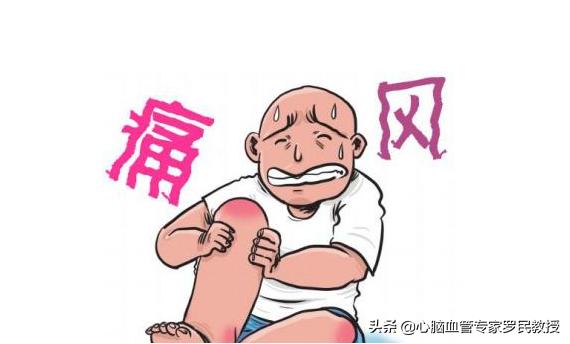
So, learn how to tell if you have gout today?
1. Uric acid value, people with gout have higher uric acid value, so you can measure your uric acid value when you are not sure if you have gout, but not everyone with high uric acid value has gout.
2. Symptoms occur more than once. Symptoms of gout don't usually occur just once, or they may occur once in a while and then not occur again.
3. The pain of gout manifests itself in the joints and is recurring, but the diagnosis of this is more difficult. Those who are experienced can judge it very well, while those who are inexperienced will find it hard to judge whether it is the pain on the surface of the skin or in the joints, therefore, the requirements for the diagnosis of this are relatively high.
4. The color of the skin at the site of the symptomatic attack varies in patients with gout and is a dark red color.
5. Gout appears unilaterally, not bilaterally, in both the upper and lower extremities. If gouty stones are present on both sides, the attack is also unilateral, and if both sides are attacked at the same time, other diseases, such as arthritis, need to be considered.
6. Gout is usually a sudden pain, but some patients experience discomfort before a gout attack, but if the pain is slow and thus gets worse little by little, then it is not usually considered a symptom of gout.
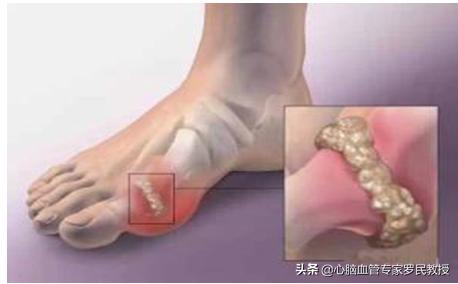
7. Gout pain is a sharp pain, and gout pain usually lasts no longer than seven days, or fourteen days if the gout is severe.
8. The symptoms of gout are mainly redness, swelling, pain and heat, and pain in the joints, usually in the lower limbs, such as the knees, ankles and toes, but also in the upper limbs, such as the joints of the hands.
9. Severe gout can lead to deformities at the joints.
After suffering from gout, eat as little high-purine food as possible, eat more low-purine food, drink plenty of water, and exercise properly.

I hope my answer helps you!
If there's anything you don't understand, comment and private message me!
Thanks for the answer!
As the standard of living improves, the number of people with "hyperuricemia" is increasing, and thus the number of people with "gout" is also increasing!


So, can you tell if you have gout if you don't go to the hospital? Yes, please see:
"Gout" is an acute onset arthritis, especially related to diet, if you ate this seafood, drank a lot of beer, or animal offal, high protein, etc., and you sleep in the middle of the night, the first metatarsophalangeal joints are painful, red, swollen, and painful, then we have to think that, especially men, may be suffering from gout. , consider that they may have gout!
You can tell if you have gout by the following points.
1, The sudden onset of localized redness, swelling, heat, and pain in distal joints (e.g., toe joints, finger joints) can cause a seemingly healthy person to be in such pain that he or she is unable to walk or wear shoes in a short time.
2, usually before the gout attack there will be triggers, such as alcoholism, eating a lot of animal offal and other foods containing high purine, resulting in a sharp increase in the level of uric acid in the blood, you can occur severe pain, and the level of pain gradually increase, within 24 hours to reach the peak.

3, 90% of gout patients are adult men. The age of onset of gout in women is almost always after menopause, and gout rarely occurs in women with normal menstruation because estrogen has a facilitating effect on renal excretion of uric acid.
When I received this topic, in fact, my heart refused to write this article, because for medical treatment, the most economical way or "go to the hospital", so that you can avoid less detours. However, when I think about it, gout is a somewhat unique disease, even if you go to the hospital, many patients are misdiagnosed, this is the case, please colleagues do not spray.
The gold standard for the diagnosis of gout is the discovery of uric acid crystals by puncture fluid from the lesion site or gouty stones, which is not routinely performed because of the difficulty of obtaining the material and its relatively lesser significance. If a patient comes to see me with swollen feet and I say I'm going to give him a puncture, I guess it's the patient himself who is reluctant.
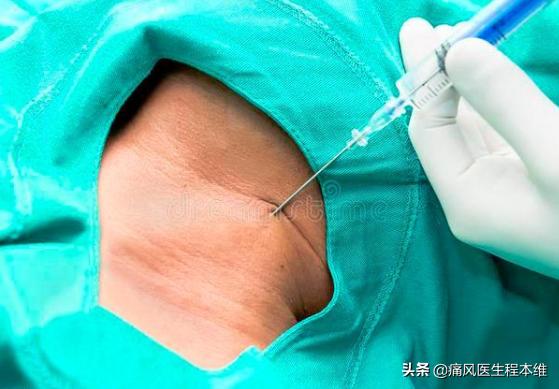
Therefore, the commonly used diagnosis nowadays is usually an empirical diagnosis by doctors, which is why I wrote this article, because when you also know how to diagnose, you are indeed able to know if you have gout without going to the hospital for a checkup. Besides, some hospital doctors are not very experienced and usually think that swollen feet + high uric acid = gout, which is obviously wrong and can lead to misdiagnosis! Next, let's talk about dryness!
Recommendations for the empirical diagnosis of gout:
1, high uric acid: that is to say, high uric acid is only an empirical criterion in the standard, does not mean that high uric acid coupled with swollen feet is necessarily gout, this is the most worthwhile need to pay attention to!
2. Acute unilateral arthritic attack;
3、Monoarthritis unilateral attack, involving the first metatarsophalangeal joint;
4, unilateral attack of monoarthritis, cumulative tarsal joints: all three of the above refer to a unilateral arthritic attack, so it is important to note that an acute attack of gout is basically on one side, and the diagnosis of gout needs to be made with particular caution if it is on both sides! If a small joint like the first metatarsophalangeal joint is involved, the probability of diagnosis is increased because it is also consistent with an acute unilateral arthritic attack, as explained further below;
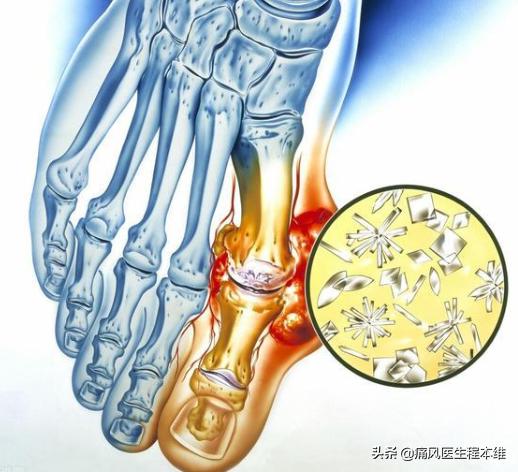
5. Episode of the first metatarsophalangeal joint: If this joint in the picture above has episodes of redness, swelling and pain, it is considered to have fulfilled 2, 3 and 5 of the above criteria at the same time, and therefore the probability of diagnosing gout is greatly increased by an episode in this joint;
6. Inflammation peaks within 1 day and can also resolve on its own: if the pain is slow and gradual, then gout is generally not considered and can resolve on its own after a few days;
7, more than one attack: gout usually does not only have one attack, if by chance it is an attack, and then never have an attack again, also do not consider gout;
8. The affected joints are seen to have dark red skin;
9. There are suspected gouty stones, as shown below:
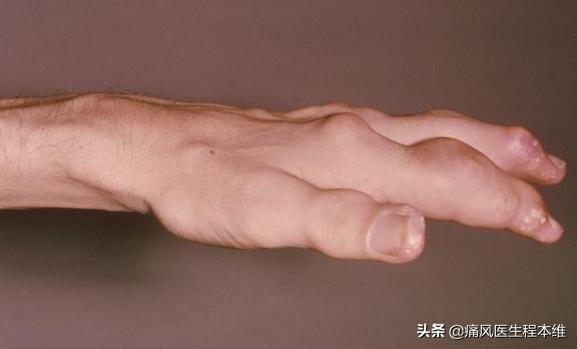
10. Gout must be pain within the joints; some pains manifested only in the skin, such as redness and swelling of the forearm, are certainly not in the joints and can be ruled out. However, this diagnosis is a bit of a problem for the common man, as it is very demanding in terms of experience;
11. Recurrent pain inside the joints;
12, exclude is inflammatory acute, this is also more difficult to identify, but also can still be through there is no fever and other symptoms to exclude, because gout generally does not cause fever.
If 6 or more of these 12 criteria are met, a diagnosis of gout is basically made!
If you like my articles, please follow Dr. Orthopedic Wang for more quality articles updated regularly! Please keep this article in your favorites and forward it to those who need it, thank you for your support!

Hello, I'm Dr. Qiao Fang from the Rheumatology and Immunology Department, formerly a general practitioner at the Sichuan Provincial People's Hospital. Let me answer this question.

The first attack of acute gout, many patients do not know what disease they are suffering from, especially after strenuous exercise, broken feet and other traumatic injuries, joints after the cold gout attack patients, will be mistaken for trauma, other types of rheumatoid arthritis, etc.; in many underdeveloped areas of the level of medical care, clinicians will often be misdiagnosed or omitted to diagnose gout, resulting in delays in treatment.
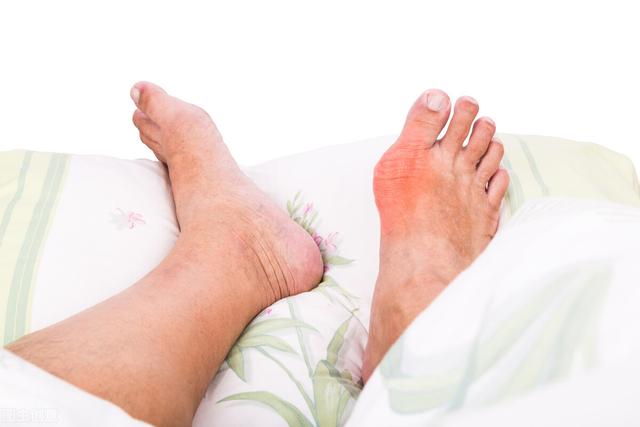
Therefore, the correct diagnosis and differential diagnosis (differentiation from other diseases with similar symptoms) of gout is particularly important.
What is the standard, accurate diagnosis in a hospital?
To date, several international criteria for the classification (diagnosis) of acute gouty arthritis have been proposed, such as the [Rome Criteria] published in 1963 and the [New York Criteria] published in 1966, which have been superseded because of their insufficient sensitivity and specificity.The 1977 classification (diagnostic) criteria of the American College of Rheumatology are widely used in clinical practice.
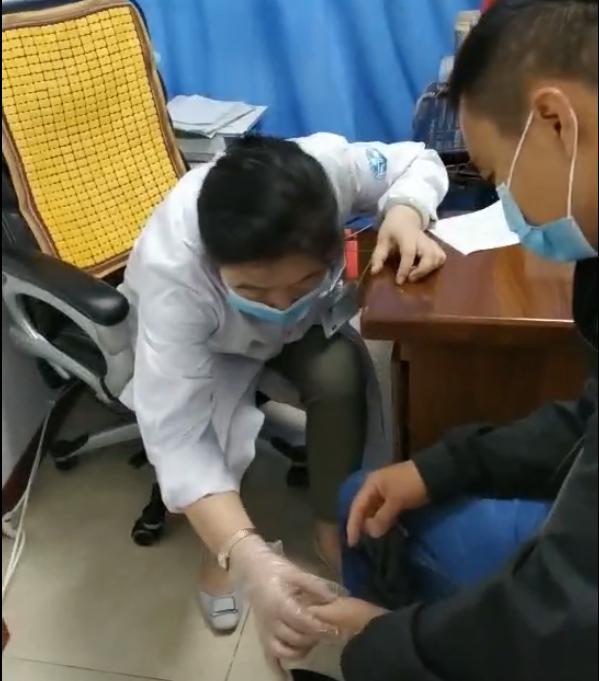
According to the American Rheumatism Association (ARA) classification (diagnostic) criteria, theAcute gouty arthritis is diagnosed when any of the following 3 conditions are met:
I. Specific (urate) crystals in the synovial fluid;
Second, gouty nodules at the joints are confirmed to contain urate crystals by chemical methods or polarized light microscopy;
III. Have at least 6 of the following 12 items:
- (1) Acute arthritis attack >1 episode
- (2) Inflammatory response peaks within 1 day
- (3) Oligo (mono) arthritic episodes
- (4) Visible redness of joints
- (5) Pain or swelling in the first metatarsophalangeal joint (the big toe of the foot)
- (6) Unilateral first metatarsophalangeal joint involvement
- (7) Unilateral involvement of the tarsal joint (where the foot joins the ankle)
- (8) Gout stones (suspected or confirmed)
- (9) Hyperuricemia (2 standard deviations above the normal population mean)
- (10) Asymmetric intra-articular swelling (confirmed by X-ray)
- (11) Subcortical cyst of bone without bone erosion (confirmed by X-ray)
- (12) Negative microbiologic cultures of joint fluids at the onset of arthritis
The accuracy (sensitivity & specificity) of this criterion for the diagnosis of acute gouty arthritis is more than 90% after many years and multiple case trials.
How to identify a gout attack after an accurate self-assessment?
As can be seen from the above ARA diagnostic criteria, the first two major conditions all require an examination to be completed in a hospital. Of the 12 conditions in the third condition [Scale Assessment], the last four also all need to be completed in a hospital examination.
但All of the first 8 can be accomplished by self-testing, and if you can fulfill 6 of them, you can more accurately determine if you are having a gout attack.
1. Acute arthritis attack > 1
2. Inflammatory response peaks within 1 day
3. Oligo(mono)arthritic episodes
4. Visible redness of the joints
5. Pain or swelling of the first metatarsophalangeal joint (the big toe of the foot)
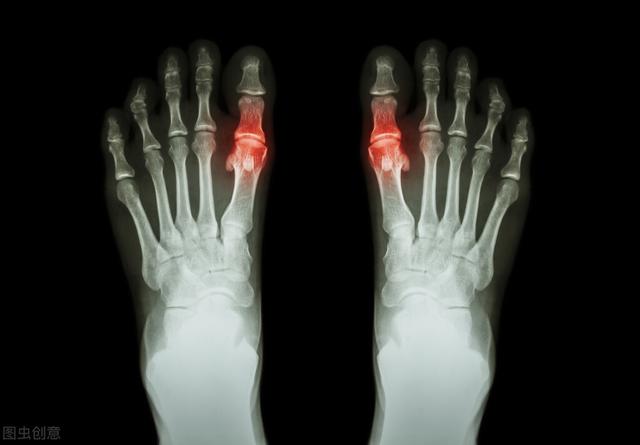
First metatarsophalangeal joint in red
6. Unilateral first metatarsophalangeal joint involvement
7. Unilateral involvement of the tarsal joint (where the foot meets the ankle)
8. Gout stones (suspected or confirmed)
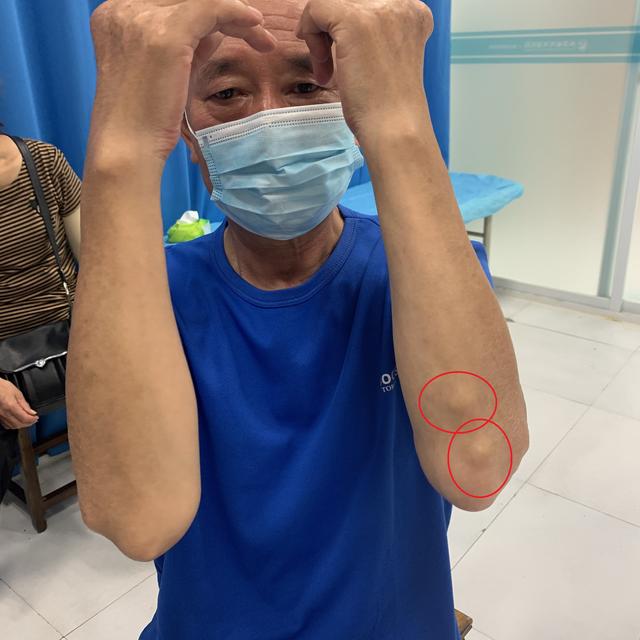
Also article 9:hyperuricemia(2 standard deviations (540umol/L) above the normal population mean,). Many of you will find out if you have excess blood uric acid during your physical exam. This article can also be realistically assessed on its own merits.
Patient self-testing criteria is not accurate, still recommended to go to the hospital to see a doctor
Although the above scale can self-test for an acute gout attack and is over 90% accurate. Howeverpatients do not have sufficient clinical experience to assess the criteria.For example, the location of the metatarsophalangeal and tarsometatarsal joints is not understood, and it is not clear whether the site of pain is subcutaneous, joint cavity or adjacent soft tissue; special attention should be paid to features such as unicompartmental and asymmetric episodes.
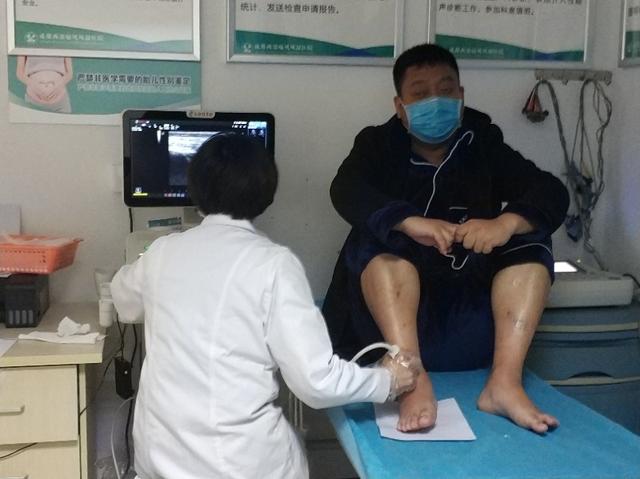
Many patients will have a preconceived notion that they have gout, and then the more they look like it according to the criteria, the more likely they are to come to the wrong conclusion.And the accuracy of this scale itself is not 100 percent, with a 10.9 percent positive rate for misdiagnosis of pseudogout and a 1.3 to 2.8 percent positive rate for other non-gouty arthritis patients.
Therefore, it is recommended that patients with similar symptoms of acute gout should seek the help of a professional rheumatologist. With the support of professional testing instruments, the results will be more accurate; with the doctor's diagnosis and analysis, the subsequent use of medication will also be safer and more secure.
It is not easy to organize and publish! If you agree with my point of view, please help point a concern or point a praise; if you have a different point of view, you are also welcome to leave a message below, we can discuss together; you can also forward to your side of the need of friends; thank you!
This question and answer are from the site users, does not represent the position of the site, such as infringement, please contact the administrator to delete.